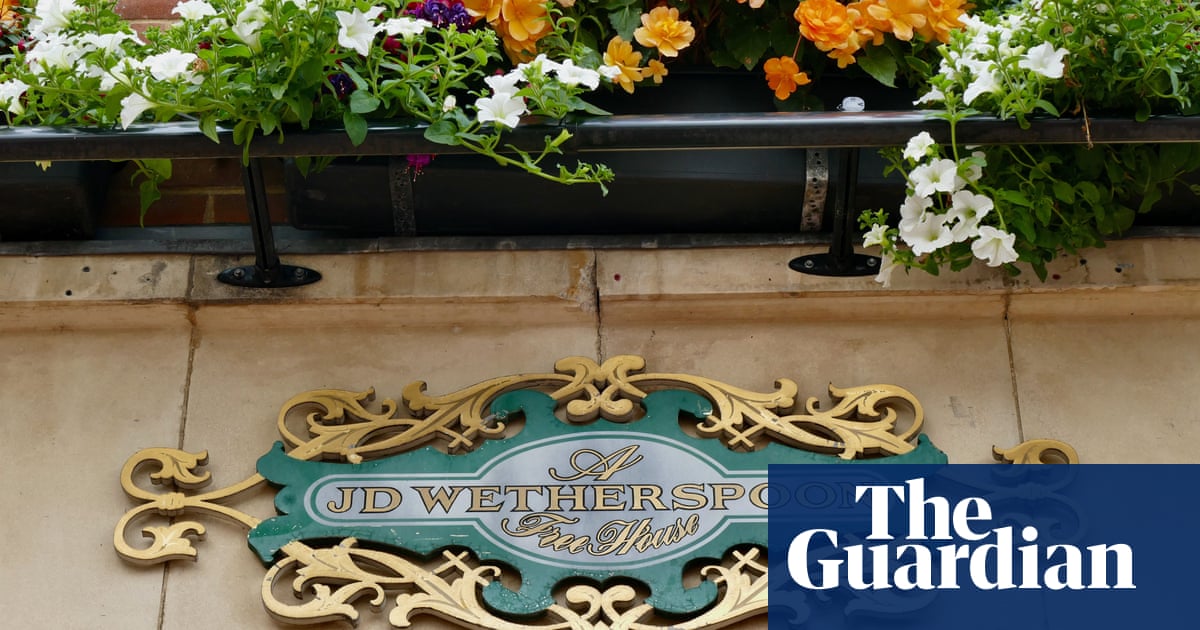
JD Wetherspoon has bounced back to profit for the first time since the start of the coronavirus pandemic three years ago, as budget-conscious consumers flocked to the low-cost pub chain amid the cost of living crisis.
Wetherspoon’s, which runs about 830 pubs across the UK and Ireland, reported a pre-tax profit of almost £43m in the year to 30 July.
It is the first time the pub chain has reported an annual profit since 2019, when it made profits of £102m. It announced a £30m loss in its previous results.
The start of the pandemic in 2020 fuelled the first annual loss since the company was founded by Tim Martin in 1984.
The company made three consecutive annual losses – in 2020, 2021 and 2022 – totalling £230m.
“Wetherspoon’s continues to recover from the pandemic hangover which has left some stains on the business, but where progress is increasingly evident,” said Richard Hunter, the head of markets at Interactive Investor.
The company reported annual sales of £1.9bn, up 12.7% on a like-for-like basis, as cash-strapped consumers turned to its cheaper food and drink offerings.
Bar sales increased by 9% year on year, food sales soared by 16.7%, hotel room revenue increased by 11.8%, and sales for the pub chain’s slot and fruit machine operations rose by 26.4%.
Martin said trading in Wetherspoon’s new financial year has been strong, with sales up 9.9% year on year in the nine weeks to 1 October, but was more cautious about prospects for the full year.
“As we said last year, perhaps the biggest threat to the hospitality industry is the possibility of further lockdowns and restrictions,” he said. “The company currently anticipates a reasonable outcome for the financial year, subject to our future sales performance.”
Despite the return to profitability, the company decided against reinstating a dividend for investors, which, combined with a less than bullish outlook for the year, led to shares in Wetherspoon’s falling by 4% on Friday – making it one of the biggest fallers among FTSE 250 companies.
Wetherspoon’s also revealed that executive and non-executive directors took home £2.4m in total remuneration last year, slightly down on the £2.58m last year.
While no cash bonuses were paid out to top executives, they received shares in the company’s long-term incentive scheme.
The highest-paid director was John Hutson, the chief executive, who took home a total remuneration package of £1.07m, his biggest pay packet since 2018.
For this year he will receive a 6% rise to his 638,000 annual salary, while staff will receive a 6.7% average rise.
Wetherspoon’s, which employs 42,000 staff, said that employees received £36m in bonuses and share awards, of which 98.6% was paid to staff below board level and 83.4% was paid to staff working in pubs. This compares with £30m in its last financial year.
The company kept a tight control of costs, which have been hit by food, energy and labour cost inflation, which rose by about £100m to £1.8bn.
Employee costs rose 5.5% from £692m to £730m, while administration costs grew from £45m to £53m.
The company’s operating margin was 5.6%, an improvement on the “wafer-thin” 1.5% the previous year.
“While sales may have returned to something resembling normality, the pressure on margin and profit remains evident,” Hunter said. “Wetherspoon’s has been able to pass on some of the inflationary costs without diminishing its appeal, but equally, it will be mindful that this particular strategy needs to be reined in where possible in order to maintain its no-nonsense and no-frills value offering.”












